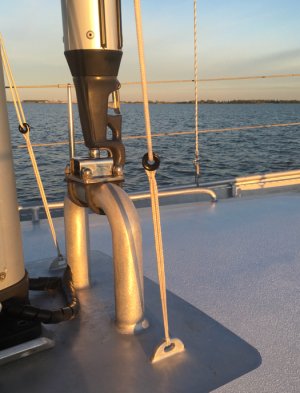flaming
Well-Known Member
I make them whilst watching TV in the evening. Been experimenting with soft shackles integrated into strops. Made a couple to test, will see if they work!
Yep, what we do too. I had great fun splicing up my inhauler system. We run it off one tail, so that both sides adjust the same. Getting 2 dynema lines with an eye splice in both ends to be exactly the same length was more challenging than I'd anticipated...I’ve got LFRs spliced into strops for my barber haulers, that has worked well.
Will you throw a strop if they do not?I make them whilst watching TV in the evening. Been experimenting with soft shackles integrated into strops. Made a couple to test, will see if they work!
When a very small error would screw it all up, yes. We have that system on the XOD, in 3mm. It took a while to get both sides the same, or so close it couldn’t be measured, rather.Yep, what we do too. I had great fun splicing up my inhauler system. We run it off one tail, so that both sides adjust the same. Getting 2 dynema lines with an eye splice in both ends to be exactly the same length was more challenging than I'd anticipated...
Does she have a sister?For those of you that do your own work with Dyneema here are some photos of my wife’s work using LFR that may give you some ideas.
I cannot answer that but I can verify that "the mermaid" has an astonishing enthusiasm for knots.Does she have a sister?
I strip the outer cover off retired dyneema sheets and halyards for this very application. Based on a suggestion here I use the covers for fenders, sail ties and tie downs on a roof rackI’ve got LFRs spliced into strops for my barber haulers, that has worked well.
Indeed! Not only are Melba toast and Peach Melba named after her, they were created for her.Dame Melba, an Australian, was a singer held in high regard, hence the 'Dame'. I'm sure she would have been described by some, at the time, as a peach.
Jonathan
Some very neat work there! Much better than anything I'm doing. I'm intrigued as to what the first one is for though?For those of you that do your own work with Dyneema here are some photos of my wife’s work using LFR that may give you some ideas.
View attachment 180344
View attachment 180345
View attachment 180346
He can't reply - he's a bit tied up at the moment!Some very neat work there! Much better than anything I'm doing. I'm intrigued as to what the first one is for though?
We use 'em all over the place and haven't had one come undone - I have had a stainless shackle come apart once.I bought some as I thought it might be a good idea. I'm still looking for an application where I could use them . I don't have the courage to use them for halyards . Not that they don't have the strength but the fear of coming undone.
Thanks. It is a low friction ring connected to a HMWPE loop. The loop can be quickly attached with a cow hitch. I think the one pictured in post #46 was made as a barber hauler for our previous yacht.Some very neat work there! Much better than anything I'm doing. I'm intrigued as to what the first one is for though?

Same here. This includes applications such attaching the snubber to the chain where the load cycles off and on.We use 'em all over the place and haven't had one come undone - I have had a stainless shackle come apart once.
If you use small chain, in our case 6mm, and maybe 8mm (in the dark and rain) then threading the soft shackle through a link is not so easy.Same here. This includes applications such attaching the snubber to the chain where the load cycles off and on.
... but splicing is for real men (who would not be seen crocheting) ....
Jonathan